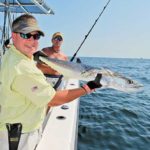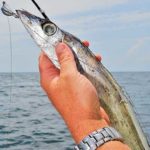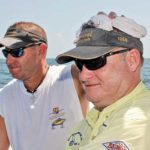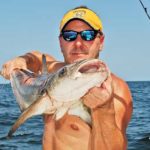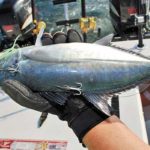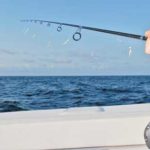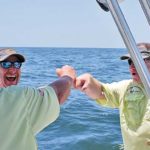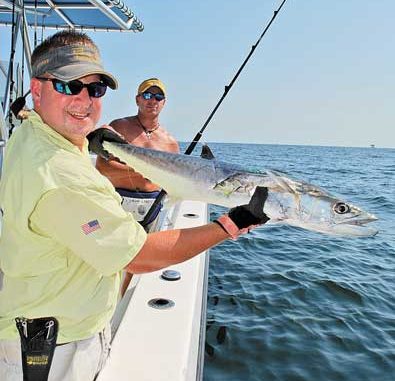
Just about anything can and will happen when anglers set out to win big cash and high honors in kingfish tournaments.
The strongly built man leaned against the heavily bowed rod. Rivers of sweat poured from under his sun visor and ran down his face. His green fishing shirt was soaked. His muscles burned with pain.
“I sure hope it’s a king mackerel,” he murmured to his three companions.
“I do too,” replied one, “but it’s not fighting like a typical kingfish.”
“Maybe it’s tail-wrapped,” replied another one. “If it’s tail-wrapped and a really big king, it could be fighting like this.”
The big guy sitting at the wheel of the 29-foot twin-V offered up his assessment.
“I don’t think it’s a big grouper,” he said. “The bait was only set at 85 feet, and we were trolling well away from the platform. It might be a yellowfin tuna, but we’re in awfully green water for that. I just don’t know.”
A small voice piped up, “Maybe it’s a sea monster.”
The four men, collectively known as “Team Oompa Loompa,” were fishing in a Southern Kingfish Association (SKA) tournament being held in Louisiana. The chemistry among the four men, Don Quick, 58, Jeff Boudreaux, 42, Jeff Mire, 45, and Scott Bynog, 38, was obvious. All carry fishing aliases.
Quick, known as “Dubby,” was a patient of optometrist Boudreaux’s for 13 years before they began fishing together. Boudreaux, a.k.a. “Boudawg,” and Bynog (Capt. S.T.) knew each other as kids. Mire (Capt. Dick) and Boudreaux have fished together for more than 20 years.
As for the name Oompa Loompa, well, they felt that they resembled in stature “those little brown midgets that Willie Wonka had running the chocolate factory.” The tallest member of the team is 5-7. Plus in their first year, they were usually in the smallest boat in the competition.
Everybody on the team has a job.
They agreed that the rosy-cheeked, cherubic Quick is the best boat handler.
“When Don broke his ribs last year in the nationals [the national SKA tournament],” says Mire, “it threw the whole team out of sync.”
Quick also seems to have a knack for enlisting sponsors, something important when fuel for the twin 250-horsepower Suzukis is over $3 per gallon.
Quick, in turn, said that the dark-haired Mire, with his laconic country-boy twang, has a sixth sense for finding fish, no matter what the species.
“He can study the conditions and tell you where the fish are,” he said.
The youthful and energetic Bynog, who could pass for the dissolute scion of Central Louisiana country aristocracy, is a meticulous rigger and gear man, and owns many of the expensive reels the team uses.
Boudreaux got the nod as “the glue that holds the team together.” Boudreaux, who looks like everybody’s favorite uncle but wears a “Dennis the Menace” grin, also owns the boat and holds the necessary National Marine Fisheries Service permits.
“Everybody has a job,” Boudreaux said, “but I’m beginning to believe some cross-training might be good.
“Two years ago during an FLW tournament out of Cocodrie, we were fishing in rough water. I went to club a king mackerel, but the fish popped up and its teeth gashed my hand wide open. There was blood everywhere.
“So I drove the boat, and Don took over running the lines. He wasn’t used to the job, and slipped in the rough seas, and ripped his forearm open on a cleat. Blood started pouring out of him; I mean gushing. He was on Coumidin and Plavix at the time.
“Even though the boat was covered in blood, we tried fishing some more. At the weigh-in, Scott was covered in our blood from the chest down. The weigh master said, ‘You must really have had a great day.’
“Afterwards, Scott took me to Terrebonne General Hospital. Don had stopped his bleeding by gluing himself up with Super Glue, so he went to a bar to recover.”
All the men love fishing competitively for king mackerel. The night before the tournament, the excitement in the motel room where they were making baits and tying leaders was electric. When they weren’t peppering each other with insults, they were cooing about competitive kingfishing.
“Kingfish are a great game fish,” Mire said. “They strike hard and they fight hard.”
Bynog agreed.
“They will peel off 300 yards of line in one run,” he said.
Part of the thrill, Boudreaux said, is in the unpredictability of the fish.
“You never know what you’re going to get,” he said. “They can sound and go down, or they can come up and dance on the water.
“And competitive fishing is highly addictive. Once you get a taste, it’s hard to let go. After you get to know the other fishermen, it really makes it more personal. Seeing, competing with and knowing the other fishermen is great.
“But, sometimes I miss fun fishing, without pressure.”
Mire agreed.
“We still try to have fun, but it’s definitely not just fun-fishing,” he said. “I miss that skinny water fishing — catching those little marsh bass. But I definitely don’t want to give up competitive fishing.”
That being the case, the team could not possibly live in a better place.
“You want to kiss the ground in Louisiana — it is so good,” Bynog said.
Mire agreed.
“It’s not just the size of Louisiana kingfish — it’s the numbers too,” he said.
Bynog jumped back in.
“Four out of five winning fish in Gulf of Mexico tournaments come from Louisiana,” he said. “Boats will run from tournaments in Galveston and Pensacola to Louisiana to fish.”
All agreed that the key to competing in tournaments held outside of the Bayou State is to have a boat that can run fast enough to get here to fish and then get back in time for weigh-in.
The alarm went off at 4 a.m. the next morning. The turbo-charged air conditioner had the room so cold that the men’s breath was visible as they hurled wisecracks at each other. Everyone was wired.
The television weatherman was predicting near triple-digit numbers for the day’s temperatures. Stepping out of the motel door was like walking into a solid wall of humidity. But the moisture in the air didn’t dim the sparkling lights of Fourchon; nor did it dampen the enthusiasm of Team Oompa Loompa.
They cranked the boat up, and left at first daylight. Even though they planned to stop halfway to the West Delta area to catch live bait, leaving earlier would have been pointless. Tournament rules prohibit any lines in the water, including those to catch bait, until 7 a.m.
Belle Pass was bustling with oilfield work boats and offshore crewboats. Buzzing past them and the occasional lumbering shrimp boat were outgoing sportfishers. Quick put the boat in neutral and led the group in a short prayer: “Dear Lord, forgive these men for the slaughter they are about to commit.”
Ten miles out, the boat slowed down and pulled up to an oil and gas platform. Bynog hopped up on the bow deck with a sabiki-rigged spinning rod to try to catch the hardtails the men prefer for live bait. It was 7 a.m. sharp.
Bynog dropped the rig of tiny jigs down, and worked them back up vigorously. Nothing. Quick moved the boat off all four corners of the platform and both upcurrent and downcurrent of the oil rig. Still nothing.
They moved the boat to another platform. All it produced was a small lesser amberjack, in spite of Bynog’s seductive offerings. Both of these rigs had proven to be dependable bait producers in the past, but they were barren today.
As they neared the next platform, the men exchanged nervous looks. They had brought frozen ribbonfish with them, but they wanted live bait as well.
Bynog peered into the water.
“It’s gorgeous,” he said.
“It’s kingfish green,” replied Quick, “the green right before it turns blue.”
Bynog started whacking hardtails. He caught several each drop, and kept Boudreaux and Mire busy gently unhooking them and placing them in the boat’s big livewell. Bynog, a stickler for gear, changed rods everytime he felt that the sabiki rigs were the least bit messed up.
When the fish became wary of the men’s offerings, Quick moved the boat to another double platform connected by a walkway. Bynog scored more hardtails and a small red snapper, which was quickly returned to the water.
When they reached their West Delta target spot, they put three lines out to troll. One line, set on a downrigger to fish at 90 feet deep, was baited with a live hardtail. A skirted duster was put on an 18-inch hard-wire leader ahead of a 3/0 J-hook, which was hooked through the nose of the hardtail. Wired to the eye of the J-hook was an 8-inch leader with a treble hook stinger on its terminal end. One hook of the treble hook was buried under the skin of the hardtail. For big hardtails, they may use more than one stinger, they explained.
Another line, set on a downrigger to fish at 70 feet, was rigged with a ribbonfish. The ribbonfish rig did not have a duster, and the straight J-hook was replaced with a Dave Workman King Jig. This jig head is designed to keep the ribbonfish upright during trolling.
Stingers were spaced 6 to 8 inches apart, with the complete rig having anywhere from 3 to 5 stingers. The men carefully cut the pectoral fins off of each rigged ribbonfish with scissors to help keep them from spinning during trolling.
The final line, a flat line baited with a live hardtail, was rigged to troll within 3 feet of the surface. The rod holding this line was stabbed in a holder in the center of the boat’s T-top. The mainline on all three rods was 20-pound-test, and the reels’ drags were set at 6 pounds.
Trolling was done slowly, perhaps 1½ to 2 mph. Quick explained that pulling live bait too fast will kill it. He often trolls with one engine out of gear when trolling downcurrent. Sometimes, he says that he will have to “bump-troll,” taking the engine in and out of gear to keep the trolling speed low enough.
Quick and Boudreaux explained that they picked this spot today because of its history, the water color and it having the ideal summer water temperature of 86-88 degrees. In the dead of summer, the men look for cooler water. In October and November, they look for warmer water, at least 78 degrees, but the warmer, the better.
Zing!
Their discourse was interrupted by Bynog hollering, “There it is; there it is!”
But they never felt the fish. Only the head of the ribbonfish was left.
“How did it get past all those treble hooks,” marveled Boudreaux.
While they re-rigged the ribbonfish line, a good-sized cobia came up and started chasing the flat line’s bait on the surface. It swatted the bait in the air and then inexplicably gave up.
“Shoot, I hate that,” grunted Mire.
Boudreaux looked at the grinning Quick.
“He sure loves them things,” he said.
“Well, ‘Lemon Chaser’ is the name of my boat,” Mire replied in self-defense. “It’s my favorite fish to catch, and it’s the toughest fish in the ocean to gaff. They go ballistic.”
Quick stoically listened and piloted the boat.
Suddenly, behind the trolled baits, a kingfish missiled out of the water, and then the reel with the ribbonfish bait on it sizzled. The men scrambled to get the flat line and the other downrigger line reeled in. One strapped a fighting belt on Mire.
“He might weigh,” said Mire, more in hope than anything else.
When the fish neared the boat, shimmering like green-tinged quicksilver, Mire spit.
“He’s skinny,” he said.
“Yeah, long and slender,” agreed Bynog, who tailed the 18- to 20-pound fish, and quickly released it.
“It’s not big enough to win, and we’re not gonna take it home,” explained Quick. “Why kill it? Let it grow up. We’ll catch it next year.”
A hardtail set at 50 feet on a downrigger produced the next hit. Boudreaux grabbed the rod while the others retrieved the other two lines.
“Easy, Dawg, easy,” coached Quick. “That’s $10,000 [first prize in the tournament] on the end of that reel.”
The fish came in quickly. To their enormous disgust, it was a 3-foot-long Atlantic sharpnose shark.
Swiftly, the lines were set back overboard. Quick carefully piloted the boat, his eyes glued on the GPS and the depth-recorder screens. His concentration was intense, and it was getting hot. Mire daubed Quick’s face with a towel drenched in fresh water.
When the boat passed over a big obstruction, producing a 50-foot rise from the bottom, both downrigger lines got hits. One cut off immediately. To three of the men’s delight, the remaining line produced a 6-pound red snapper.
Quick brought them crashing to earth. Is there a red snapper out there worth $10,000? He turned back to his screen and muttered to himself, “There has got to be a first for everything — a red snapper while trolling for kingfish.”
But the fun wasn’t over. A cobia had followed the snapper to the surface, and promptly took a pogie on a hook pitched to it.
Quick patiently endured the excitement like an indulgent grandfather, then reminded them, “We are a kingfish team. We are in the SKA.”
Bad luck seemed to stalk the men. Two sharks later, they made the decision to run 17 miles around the Louisiana Offshore Oil Port (LOOP) to the Grand Isle blocks. The ride was choppy enough that Boudreaux, Bynog and Mire had to ride in bean-bag chairs.
At their destination, near a large oil platform, Quick sang out that fish were all over the screen of his depth sounder. A fish immediately hit the first line out, and made a sizzling run. Quick had to chase the fish hard with the boat to keep it from spooling the reel.
It fought viciously. The whole time that it was fighting, other kings were jumping and swirling ahead and around the hooked fish. When the fish got close to the boat, it looked like a silver telephone pole. It was big! Just as the gaff snaked out to hook it, it zigged — then it was gone.
Moans, curses and oaths filled the air. The anglers were stunned.
“There’s got to be more out there where he came from,” one of them said.
Boudreaux paid out a line with a hardtail on it. It produced a hit instantly.
“This is the way king fishing should be,” shouted Bynog.
It was a good fish, making three line-peeling runs before settling down. The gaff sunk home, and the fish came on board. Hands slapped and fists bumped. Adrenaline filled the air.
But the fish only scaled 33 pounds on the boat scales — not likely to win anything.
Quickly three lines went out, producing another hit. The fish got off. Then the next strike produced a shark.
The men were down to one live hardtail, a really big one.
At 2:09 p.m., the sea monster hit the last hardtail. It was Boudreaux’s turn on the rod.
The fish stubbornly stripped line from the reel.
“How does it feel,” asked Mire.
“Whatever it is, it’s big,” was the reply.
Fifteen minutes passed, and the men still couldn’t see any color. All they saw was the gossamer monofilament thread leading into the water. It was see-saw. Boudreaux recovered line, then the fish stripped it off.
The battle was brutal. At 35 minutes, the fish made a run around the boat. Quick carefully maneuvered the boat to keep the stern away from the fish, but Boudreaux still had to follow the fish around the bow and then back again. Bynog took on the role of a goading coach, pushing Boudreaux not to let the fish whip him.
At 55 minutes, Boudreaux croaked hopefully, “I think something might be happening.”
Bynog continued to challenge him.
“You’re getting your butt kicked — what else?” he said.
Mire wrapped an icewater-soaked towel around Boudreaux’s neck.
After 1 hour and 20 minutes, the men fell silent. Even Bynog ran out of quips.
Quick constantly maneuvered the boat in an attempt to keep Boudreaux in the shade of its T-top.
At 1 hour and 50 minutes, Bynog got his second wind, and began to harass Boudreaux again. Mire piled a fresh water-soaked towel on top of Boudreaux’s head to cool him down. The muscles in Boudreaux’s arms began to visibly twitch.
At 2 hours and 35 minutes, the line abruptly snapped. Boudreaux collapsed on the deck. Mire stood staring at the frayed end of the line in his hand.
“It looks like a tail-wrap, whatever it was,” he muttered.
The boat had drifted 2.97 miles from the hook-up.
With no more live bait and the day getting long, they decided to head for the barn. Back at tournament headquarters, a 58.62-pound kingfish led the board.
Team Oompa Loompa would have its work cut out for it the second and final day of the competition.
